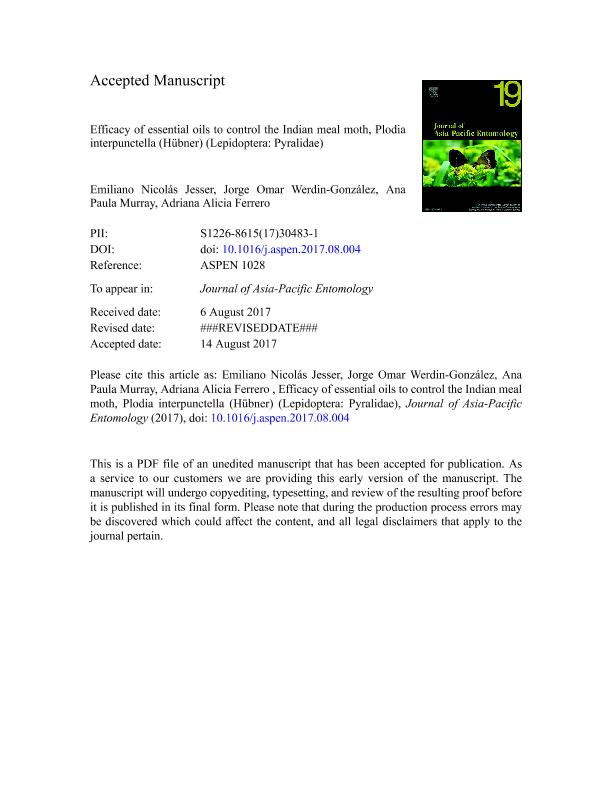Artículo
Efficacy of essential oils to control the Indian meal moth, Plodia interpunctella (Hübner) (Lepidoptera: Pyralidae)
Jesser, Emiliano Nicolás ; Werdin Gonzalez, Jorge Omar
; Werdin Gonzalez, Jorge Omar ; Murray, Ana Paula
; Murray, Ana Paula ; Ferrero, Adriana Alicia
; Ferrero, Adriana Alicia
 ; Werdin Gonzalez, Jorge Omar
; Werdin Gonzalez, Jorge Omar ; Murray, Ana Paula
; Murray, Ana Paula ; Ferrero, Adriana Alicia
; Ferrero, Adriana Alicia
Fecha de publicación:
12/2017
Editorial:
Elsevier
Revista:
Journal of Asia-Pacific Entomology
ISSN:
1226-8615
Idioma:
Inglés
Tipo de recurso:
Artículo publicado
Clasificación temática:
Resumen
Essential oils (EOs) have been recognized as an important source of biopesticides. This work investigated the chemical constituents and bioactivity of six essential oils namely lavender (Lavandula angustifolia Mill.), peppermint (Mentha piperita L.), geranium (Geranium maculatum L.), palmarosa (Cymbopogon martinii (Roxb.) Wats), eucalyptus (Eucalyptus globulus Labill.) and bergamot (Citrus bergamia Risso) against adults of the Indian meal moth, Plodia interpunctella, a cosmopolitan pest that infests a wide range of stored products. Analysis by gas chromatography coupled to mass spectrometry (GC–MS) revealed the presence of several compounds, mainly mono- and sesquiterpenes. The contact toxicity assay showed that the EO from palmarosa was the most toxic with a LD50 value of 22.8 μg cm− 2. The toxicity order was palmarosa > geranium > peppermint > lavender > bergamot > eucalyptus. In fumigant toxicity assay, the greatest effect was found with the EO from eucalyptus with a KT50 value of 8.34 min. The toxicity order was eucalyptus > peppermint > geranium = lavender > bergamot > palmarosa. The EO from palmarosa showed the highest residual activity when the insects were exposure to its volatiles constituents. Finally, all EOs produce sublethal activity promoting effects in the fecundity. In conclusion, the EOs could be used as potential biopesticides for P. interpunctella control.
Archivos asociados
Licencia
Identificadores
Colecciones
Articulos(INBIOSUR)
Articulos de INSTITUTO DE CIENCIAS BIOLOGICAS Y BIOMEDICAS DEL SUR
Articulos de INSTITUTO DE CIENCIAS BIOLOGICAS Y BIOMEDICAS DEL SUR
Articulos(INQUISUR)
Articulos de INST.DE QUIMICA DEL SUR
Articulos de INST.DE QUIMICA DEL SUR
Citación
Jesser, Emiliano Nicolás; Werdin Gonzalez, Jorge Omar; Murray, Ana Paula; Ferrero, Adriana Alicia; Efficacy of essential oils to control the Indian meal moth, Plodia interpunctella (Hübner) (Lepidoptera: Pyralidae); Elsevier; Journal of Asia-Pacific Entomology; 20; 4; 12-2017; 1122-1129
Compartir
Altmétricas



